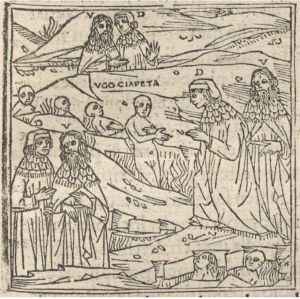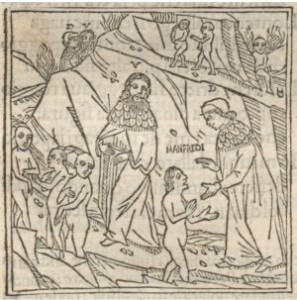Not long after Johannes Gutenberg invented an improved movable type mechanical printing system in Europe around 1450, the first woodcut book illustration was printed in 1461. Woodcuts can be easily printed together with movable type because both are relief-printed (a process by which protruding surface faces of the printing plate or block are inked; recessed areas are ink free). Woodcutting is also credited as the oldest technique used for old master prints. Famous artists and printers such as German Michael Wolgemut and Erhard Reuwich, perfected the art of book woodcut illustration. Moreover, Albrecht Dürer , brought the single-leaf woodcut to a truly superior level.
At the same time, various Italian artists were also raising standards with Venetian woodblocks in superbly decorative printed books. Typographer Bernardinus Benalius (Bernardino Benali) is estimated to have printed more than 80 editions of various works that ultimately vanished over time. Venetian printing had just been introduced to the printing press, but production was still in very small quantities. Furthermore, a fire on January 4th, 1529 in the monastery of St. Stefano, which was home to a great deal of warehouses of booksellers, destroyed a vast amount of books. The fire was particularly unfortunate because the monastery had been “isolated,” because of an outbreak of plague. Thus, the fire wound up destroying the inventory of a great amount of books by Giovanni Bartolomeo, and also Benali’s volumes that had been stored on the monastery premises at that time.
Benali’s work is noted for its very beautifully engraved illustrations, and generally for the quality of his iconography. The following comprises the more important of his printings: the Commedia di Dante of 1491; Miracoli della Madonna “ the Miracles of the Madonna” (2 May 1491); Monte dell’ Orazione (undated); le Meditazioni della vita di Cristo “Meditations of the life of Christ” (1491); l’Esopo con il volgarizzamento di Accio Zucco “the Aesop with the translation of Accio Zucco” (1492-93); il Giardino di orazione di Nicolò da Osimo “the Giardino di orazione of Nicolò da Osimo” (dated 1494); and the Ovidius in the original text (1493-94).
[1]
A copy of the very scarce first edition of Dante’s Divine Comedy printed by Bernardino Benali and Matteo Capcasa, containing a set of woodcuts depicting paradise along with Dante’s poetry, is available for sale for $86,350. The price adjusted downward to account restoration of two leaves that were re-margined and possibly sourced from another copy.
Ten years ago, a copy of the Monte dell’ Orazione sold at a Christie’s auction for $7,500. A different copy is being offered today for sale for $35,000 by a dealer. The book contains on the first recto the full-page cut of John the Baptist and St. Peter in a desert landscape, with symbols bearing the Christogram and the Holy Spirit. The book is the first edition of the private devotional and signifies the first use of the free full-page woodblocks.
Collector interest for books from this period decorated with early woodcuts has dropped significantly since the middle of the 20th century. In his essays, the president of the Guggenheim Foundation, Gordon Ray, recorded the explosive growth of institutional buying during the 1950’s and 60’s [2]. The drop in demand was primarily the result of a shift in institutional buying that had started during the ‘70’s. It was estimated that in 1965 that 60% of the total purchasing money was spent by libraries. Today, institutional buying is estimated to be at 5% of total buying.
A great deal of such works held by various university libraries and museums have already been scanned and made available for viewing on-line. The collector who is looking to own copies of Bernardino Benali’s masterpieces or similar Venetian printings, is better off going through the auction channel where feasible. The average prices paid for such books at such events are usually significantly lower than what is offered at various marketplaces by dealers.
[1] Cornell: Divine Comedy Image Archive, Shared Shelf Commons.
[2] “The Rare Book Market Today” by William S. Reese, Yale University Library Gazette, Vol 74, Nos 3-4 April 2000.



![DEVOZIONALE - Monte dell'Orazione. [Venezia: Bernardino Benali,prima del giugno 1493]. Monte dell' Orazione](https://rarebooksdigest.com/wp-content/uploads/2014/05/Benali-orazione-200x300.jpg)
{ 0 comments… add one now }